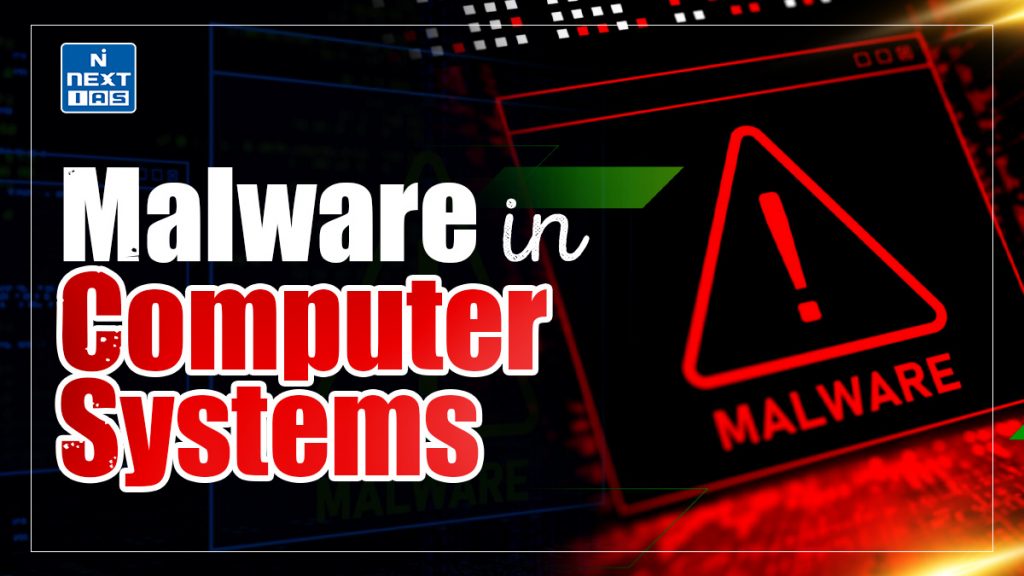
Malware, short for “malicious software,” refers to programs designed to harm, disrupt, or exploit computer systems. It includes viruses, worms, ransomware, and spyware, targeting individuals and organizations to steal data, damage operations, or gain unauthorized access. It spreads via infected files, emails, or websites, posing significant cybersecurity threats globally.
What is Malware?
- Malware, short for malicious software, is a category of software intentionally created to disrupt, damage, or gain unauthorized access to computer systems, networks, or devices.
- It includes various forms like viruses, worms, ransomware, spyware, trojans, and adware, each targeting different vulnerabilities. Malware can steal sensitive data, corrupt files, hijack system control, or spy on user activity.
- It spreads through email attachments, infected websites, software downloads, or even network vulnerabilities. Ransomware locks users out of their data until a payment is made, while spyware secretly gathers information.
- It poses significant risks to individuals, businesses, and governments, leading to financial losses, data breaches, and operational disruptions.
- Preventing malware involves using robust antivirus software, regular system updates, cautious online behavior, and awareness of phishing tactics.
- Cybersecurity measures are critical to mitigating the growing threat of malware in an increasingly interconnected world.
Types of Malware
It comes in various forms, each designed to harm, exploit, or infiltrate systems in specific ways. Key types include:
- Viruses: Self-replicating programs that attach to files, spreading when infected files are shared.
- Worms: Independent programs that replicate and spread across networks, often causing widespread disruption.
- Trojans: Disguised as legitimate software but create backdoors for unauthorized access.
- Ransomware: Encrypts data and demands payment for its release, crippling operations.
- Spyware: Secretly monitors user activity, capturing sensitive data like passwords or financial information.
- Adware: Displays unwanted advertisements, often bundled with legitimate software.
- Rootkits: Hide deep within systems to grant attackers control while evading detection.
- Keyloggers: Record keystrokes to steal personal or financial information.
- Bots/Botnets: Infect devices to form networks (botnets) used in coordinated attacks.
- Fileless Malware: Operates in system memory, leaving no trace on hard drives, making detection challenging.
Effective cybersecurity measures are crucial to mitigate these threats.
Origin of Malware
- The origin of it dates back to the early days of computing in the 1970s and 1980s. The concept of self-replicating software was first introduced in theoretical discussions by John von Neumann in the 1940s, laying the groundwork for what would later become computer viruses.
- The first recognized malware, “Creeper,” appeared in 1971 as an experimental program on ARPANET, created to test the idea of self-replication. It displayed the message “I’m the creeper: catch me if you can!” but caused no harm. To combat Creeper, the “Reaper” program was created, making it the first antivirus software.
- In the 1980s, it became more prominent with the Elk Cloner virus, which infected Apple II computers, and the rise of MS-DOS viruses. The internet boom in the 1990s and 2000s further accelerated the spread of malware, evolving into sophisticated forms like ransomware and spyware.
- Today, it continues to adapt, exploiting advanced technologies and growing connectivity.
Purpose of Malware
The purpose of it varies depending on its type and the intent of the attacker. Common objectives include:
- Data Theft: Stealing sensitive information, such as financial data, login credentials, or personal information, for identity theft or fraud.
- Financial Gain: Generating revenue through ransomware attacks, phishing, or unauthorized mining of cryptocurrencies.
- System Damage: Disrupting operations by corrupting files, crashing systems, or rendering networks unusable.
- Unauthorized Access: Creating backdoors for attackers to control systems, networks, or devices remotely.
- Espionage: Spying on individuals, organizations, or governments to gather confidential information.
- Network Disruption: Overloading systems or networks using Distributed Denial-of-Service (DDoS) attacks.
- Ad Fraud: Generating revenue by displaying or clicking on ads without user consent.
- Political or Ideological Motives: Disrupting systems or leaking information to advance political agendas.
These goals highlight the importance of robust cybersecurity measures to protect systems from malware.
Prevention from Malware
Preventing it involves adopting proactive security practices and using protective tools. Here are key measures:
- Install Antivirus Software: Use reputable antivirus programs to detect and remove malware.
- Update Software Regularly: Keep operating systems, browsers, and applications updated to fix security vulnerabilities.
- Enable Firewalls: Use firewalls to block unauthorized access to your system or network.
- Practice Safe Browsing: Avoid clicking on suspicious links or downloading files from untrusted sources.
- Be Cautious with Emails: Do not open attachments or click links in emails from unknown senders.
- Use Strong Passwords: Employ complex passwords and enable two-factor authentication for extra security.
- Avoid Pirated Software: Download software only from trusted and official sources.
- Backup Data: Regularly back up data to recover files in case of malware attacks.
- Educate Users: Train individuals and employees to recognize phishing attempts and social engineering tactics.
- Use Ad-blockers and Anti-spyware: Reduce exposure to malicious ads and tracking software.
By combining these strategies, users can significantly reduce the risk of malware infections.
Recent Malware’s in the World
Recent threats illustrate the growing sophistication of cyberattacks. Examples include:
- AsyncRAT: Leveraging AI-driven development, this malware can record keystrokes and deploy additional malware using innovative HTML smuggling techniques.
- FakeUpdates (SocGholish): A JavaScript-based downloader that compromises devices by installing additional malware like Dridex and NetSupport. It was the most prevalent malware globally in September 2024.
- Play Ransomware (Linux Variant): Targets VMware ESXi servers with encryption-based attacks, underlining the expanding ransomware scope.
- Daixin Team: A ransomware group targeting sensitive healthcare data, demanding multimillion-dollar ransoms.
- Joker Malware: A persistent threat to mobile devices, stealing sensitive information and facilitating unauthorized transactions.
Malware attacks increasingly exploit AI, advanced encryption, and cross-platform vulnerabilities, underscoring the need for robust cybersecurity measures.
Way Forward
To combat malware effectively, prioritize proactive measures like regular system updates, robust antivirus solutions, and user education on phishing and suspicious activities. Employ multi-factor authentication, strong passwords, and encrypted networks for data protection. Organizations should invest in advanced threat detection, regular backups, and incident response plans to mitigate potential impacts.
Conclusion
It remains a significant cybersecurity threat, evolving in sophistication to exploit vulnerabilities and disrupt systems. Its varied forms target individuals, businesses, and governments, causing financial and operational harm. Proactive measures like robust security protocols, employee education, and regular system updates are crucial to safeguarding against this persistent and dynamic menace.
GS - 3





